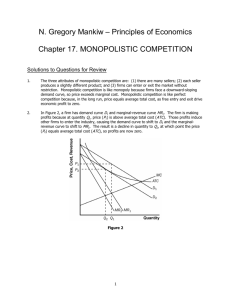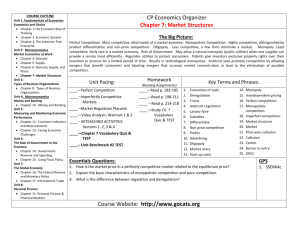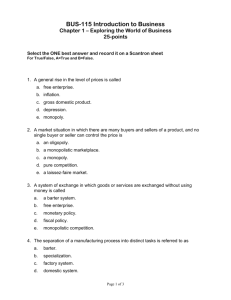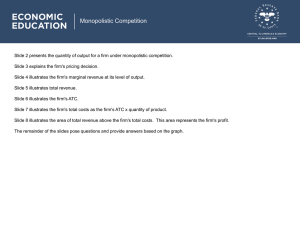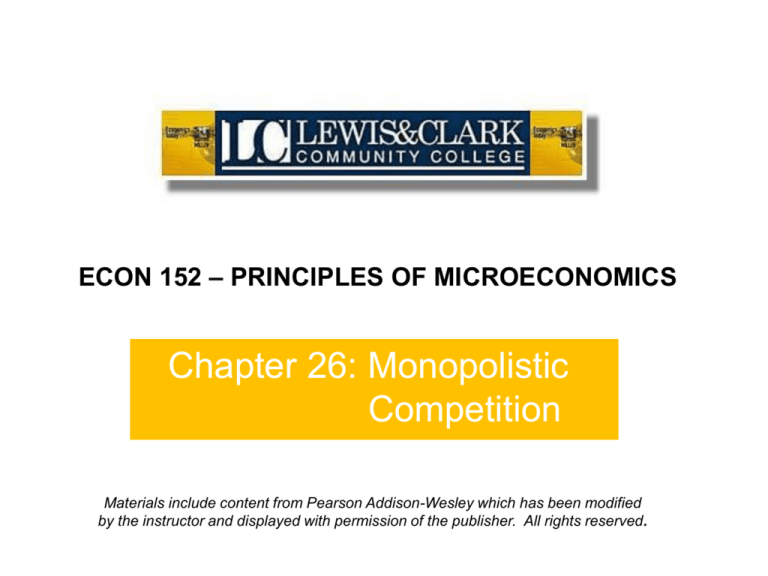
ECON 152 – PRINCIPLES OF MICROECONOMICS
Chapter 26: Monopolistic
Competition
Materials include content from Pearson Addison-Wesley which has been modified
by the instructor and displayed with permission of the publisher. All rights reserved.
Monopolistic Competition
Monopolistic Competition
A
market situation in which a large number of
firms produce similar but not identical
products
Entry into the industry is relatively easy
2
Monopolistic Competition
Characteristics of monopolistic competition
Significant number of sellers in a highly
competitive market
Differentiated products
Sales promotion and advertising
Easy entry of new firms in the long run
3
Monopolistic Competition
Implications of the large number of firms
Small market share
Lack of collusion
Independence
4
Monopolistic Competition
Product Differentiation
The distinguishing of products by brand
name, color, and other minor attributes
5
Monopolistic Competition
Product differentiation and price
Differentiate perfectly
Producer is a monopoly
Significant influence on price
Differentiation is not perfect
Producer is a monopolistic competitor
The more successful it is at differentiation, the more
control it has over price
6
Monopolistic Competition
Sales promotion and advertising
Can
increase demand for a firm
Can differentiate a firm’s product
Should be continued to the point at which the
additional revenue from one more dollar of
advertising just equals that one dollar of
marginal cost
7
Short-Run Equilibrium with Monopolistic
Competition (with profits)
Panel (a)
MC
Dollars per Unit
ATC
P1
d
ATC
Profits
• Price (P1) > ATC
• Economic profit
A
MR
q
Quantity
Figure 26-1, Panel (a)
8
Short-Run Equilibrium with Monopolistic
Competition (with losses)
Panel (b)
Dollars per Unit
MC
ATC
ATC
P1
d
Losses
A
-Price (P1) < ATC
-Economic loss
MR
q
Quantity
Figure 26-1, Panel (b)
9
Short-Run and Long-Run Equilibrium with
Monopolistic Competition (break even)
Panel (c)
Dollars per Unit
MC
P1=
ATC
ATC
T
d
A
MR
-Price (P1) = ATC
-Normal rate of return
q
Quantity
Figure 26-1, Panel (c)
10
Comparing Perfect Competition
with Monopolistic Competition
Perfect Competition
Monopolistic Competition
One of many sellers , no
barriers to entry, and no
long term profit
One of many sellers, no
barriers to entry, and no
long term profit
Perfectly elastic demand
(price taker)
Faces elastic market
demand (price maker)
Must only produce more
to sell more
Must lower price
to sell more
All units sold for price
equal to MR (P=MR)
All units sold for price
greater than MR (P>MR)
11
Comparing Perfect Competition
with Monopolistic Competition
In perfect competition, the long-run equilibrium
occurs where average total cost is minimized.
This does not occur in monopolistic competition.
Some have argued that this is not necessarily a
waste of resources, as the added cost arises
from product differentiation that allows
consumers to have more choice.
12
Comparison of the Perfect Competitor
with the Monopolistic Competitor
Panel (a)
Perfect Competition
MC
MR = P
Minimum ATC
Dollars per Unit
d
P1
ATC
MC
ATC
Minimum ATC
Dollars per Unit
Panel (b)
Monopolistic Competition
P2
d
MR
q1
Quantity per Time Period
Figure 26-2, Panels (a) and (b)
q2
Quantity per Time Period
13
Brand Names
Firms use trademarks, words, symbols,
and logos to distinguish their product
brands from goods or services sold by
other firms
A successful brand image contributes to a
firm’s profitability
14
Advertising
Forms of advertising
Direct
marketing
Mass marketing
Interactive marketing
15
Advertising
Search goods have characteristics that can be
evaluated prior to purchase
Experience goods, such as movies and haircuts,
don’t fully reveal their value until they have been
consumed
Credence goods, such as pharmaceuticals and
professional services, usually require an expert
source of information to make a choice.
Advertising for experience goods is more likely
to be persuasive rather than informational
16
Information Products
and Monopolistic Competition
Information products, such as computer
operating systems, software, and digital
music and videos, have a unique cost
structure
Product development entails high fixed
costs, but the marginal cost of producing a
copy for one more customer is low (This is
similar to that of a natural monopoly.)
17
E-Commerce Example:
Pop-Up Ads
There have been court cases involving the
use of pop-up ads to promote competing
products when internet customers place
online orders.
The legal rulings have been moving in the
direction of allowing more interactive
advertising.
18
Cost Curves for
Information Products
Figure 26-4
19
Cost Curves
for Information Products
Sellers of information products experience
short-run economies of scale.
The average total cost continually declines
as quantity increases. (This is also similar
to the condition faced by a natural
monopoly.)
20
Monopolistic Competition and
Information Products
Computer game manufacturers operate in
a monopolistically competitive market.
In monopolistic competition, marginal cost
pricing results in losses for the firm, even
though it creates efficiencies for the
economy as a whole.
21
Infeasibility of Marginal Cost
Pricing of an Information Product
Figure 26-5, Panels (a) and (b)
22
Pricing for Information Products
In the long-run, price will equal average total cost.
This yields the long-run equilibrium condition of zero
economic profit.
Firms selling information products in a monopolistically
competitive industry will recover all their production
costs.
Customers will pay more than marginal cost, but they will
pay the minimum price necessary to call forth the
product to market.
Note: In the case of a natural monopoly, the firm does not face
competition. The demand curve for the firm is that of the entire
industry, so the result is a price that tends to exceed ATC. That is
why long term economic profits are possible.
23
ECON 152 – PRINCIPLES OF MICROECONOMICS
Chapter 26: Monopolistic
Competition
Materials include content from Pearson Addison-Wesley which has been modified
by the instructor and displayed with permission of the publisher. All rights reserved.

